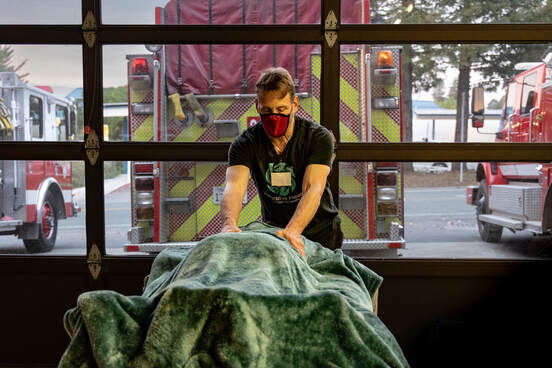|
This Saturday, October 8th marks the 5th anniversary of the devastating Tubbs Fire in Sonoma County, CA. This fire has altered our community forever. Not only from the remnants of scorched land and still vacant lots from the over 5,000 homes that burned within hours that fateful night but in the collective ethos of our 500,000 residents across the County. Reflecting back, the Tubbs Fire was a turning point for what it meant to live and work in Sonoma County. Since then, we’ve had three additional major wildfires that have led to massive evacuations and thousands of more homes destroyed. Fires in 2017, 2019, and 2020 burned more than 200,000 acres in Sonoma County, almost 20 percent of the county. We now have an official “fire season” when the community as a whole holds our breath until the first big rain of the fall or winter. And if there are any major winds or heatwaves, we know to expect either rolling blackouts or to have a go-bag with all our important documents and possessions packed.
0 Comments
As we near the end of 2021, there is much to reflect upon as we continue to navigate great collective uncertainty and challenge. We are grateful for this opportunity to share with you some of our accomplishments this past year and what we have planned for 2022. As wildfire risk grows, so does hazardous air quality. Some Northern California communities are exposed to between sixty and ninety wildfire smoke days per year now. Most of us have been exposed to smoke particles that can cause lung damage and symptoms like eye irritation, cough, sore throat, shortness of breath and headaches. These toxins can build up over time with repeated exposures.
Our bodies are designed to eliminate toxins through the skin, lungs, kidneys, bowels, and liver. Here are a few tips to help you detox after smoke exposure and protect your yourself from long-term damage: On a September Saturday in 2015 I was telling a stranger that I was from Cobb, California just as the Valley Fire set the surrounding forest on fire. That odd timing has stuck with me for the past six years. I could see the smoke from Sacramento by the next day.
Cobb was my hometown. I spent nearly half of my childhood among three hundred people, zero stoplights, two pizza parlors, and countless towering evergreens. It was wild, peaceful, dirty, simple, and had the kind of stars that you haven't even seen in your dreams. My father and I would drive midway through a creek, park the pickup, and dangle our feet into the water on a hot summer’s day. We roasted marshmallows in the wood stove when winter storms knocked out the power (again). My childhood best friend and I could spend all day in a tree with a stack of "Calvin and Hobbes" books. Her home burned to its foundations, along with the entire community of Anderson Springs. Simon Biles’ withdrawal from Olympic events has the world talking. While critics argue that only physical conditions are legitimate reasons to withdraw, many others applaud her bravery and self-awareness. I personally see IHAN’s mission in her choices: she committed to her needs and boundaries over overwhelming outside pressure. These choices are never easy, especially with pressures as large as wildfires or pandemics – or global audiences – looming over us.
I slept and dreamt that life was joy. I awoke and saw that life was service. I acted and behold, service was joy. -Rabindranath Tagore, Nobel Prize-winning Bengali poet This quote acts as an internal compass for me. We’re coming out of a year full of unforeseen hardships and heartbreak, and facing a severe drought with our fifth consecutive early fire season. How are we supposed to take care of ourselves during such difficult times? How do we find the joy that Rabindranath Tagore talks about?
Through service. We are honored to welcome Fullscript as our Community Clinics headlining sponsor. Community Clinics are the heart of our work at IHAN, providing free integrative health modalities for fire survivors, evacuees, and community members affected by climate disasters. Fullscript’s support strengthens our clinic capabilities, extends our reach, and supports our clients after their treatments.
As I write this letter I hear sirens in the background, Nixle alerts of new nearby fires, and coverage about the mass shooting in San Jose. It’s all so much. Governor Newsom’s comments about how we are becoming numb to these types of tragedies speaks to how many of us (including myself) feel as we face a much earlier wildfire season while still feeling bombarded from the last one.
When IHAN started during the devastating 2017 Tubbs Fire, we didn’t realize that we were experiencing what would become a yearly reality for millions of Californians. Signs of climate change surround us - increasing heat waves coupled with high winds, dry winters leaving hills parched and bodies of water low, months of choking wildfire smoke – placing a heavy toll on our bodies, minds, and spirits. At IHAN our daily intention is to help communities transform trauma into resilience.
Since our founding in 2017, disaster-impacted and first responder communities were our focus. Natural disasters are overwhelming, and survivors struggle to cope while their minds are locked in fight, flight, and freeze responses. These are a protective reflex against trauma, but they keep the nervous system too excited for survivors to recover and move forward. The power of community is an awe-inspiring thing. As we look at what IHAN accomplished during this incredibly challenging year, and what we have planned for 2021, it’s clear that our amazing community – you – got us here.
|
Archives
October 2022
Categories
All
|








 RSS Feed
RSS Feed